|
|
|
Obey
Plagiarist Shepard Fairey
A critique by
artist Mark Vallen
Published on the occasion of Fairey’s
Los Angeles solo exhibition, Dec., 2007.
[
View the Critical Voices
section at the bottom of this page for additional
opinions.]
|
Most
well known for his "Obey Giant" street posters,
Shepard Fairey has carefully nurtured a reputation
as a heroic guerilla street artist waging a one
man campaign against the corporate powers-that-be.
Infantile posturing aside, Fairey’s art is problematic
for another, more troubling reason - that of
plagiarism.
Lincoln
Cushing, Josh
MacPhee, and Favianna
Rodriguez, worked closely with me on researching
this article, having initially brought Fairey’s
plagiarism to my attention. Cushing is an art
historian and author of
Revolución: Cuban Poster Art,
Visions of Peace & Justice, and
Chinese Posters: Art from the Great Proletarian
Cultural Revolution. Josh MacPhee is an
artist, activist and author of Stencil
Pirates: A Global Survey of the Street Stencil,
and Favianna Rodriguez is an artist, activist
and Chicana print maker. Their invaluable research
and documentation provides the foundation for
most of what appears in this article.
|
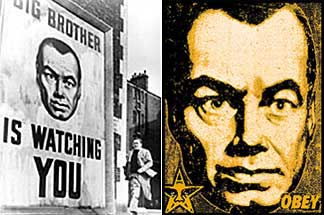 |
[
Left: Still from director Michael
Anderson’s 1956
film adaptation of George Orwell’s
cautionary story of a dystopic future,
1984. Right: Fairey
unmistakably stole his image from
the "Big Brother is Watching You"
propaganda posters used in Anderson’s
film, without crediting the source.
|
|
|
What
initially disturbed me about the art of Shepard
Fairey is that it displays none of the line, modeling
and other idiosyncrasies that reveal an artist’s
unique personal style. His imagery appears as
though it’s xeroxed or run through some computer
graphics program; that is to say, it is machine
art that any second-rate art student could produce.
In
fact, I’ve never seen any evidence indicating
Fairey can draw at all. Even the art of Andy Warhol,
reliant as it was upon photography and mass commercial
imagery, displayed passages of gestural drawing
and flamboyant brushstrokes.
|
|
Fairey
has developed a successful career through expropriating
and recontextualizing the artworks of others,
which in and of itself does not make for bad art.
Pop artist Roy Lichtenstein based his paintings
on the world of American comic strips and advertising
imagery, but one was always aware that Lichtenstein
was taking his images from comic books; that was
after all the point, to examine the blasé and
artificial in modern American commercial culture.
When Lichtenstein painted Look
Mickey, a 1961 oil on canvas portrait
of Mickey Mouse and Donald Duck, everyone was
cognizant of the artist’s source material - they
were in on the joke. By contrast, Fairey simply
filches artworks and hopes that no one notices
- the joke is on you.
Plagiarism
is the deliberate passing off of someone else’s
work as your own, and Shepard Fairey may be unfamiliar
with the term - but not the act. This article
is not about the innocent absorption of visual
ideas that later materialize unconsciously in
an artist’s work, we do after all live in a maelstrom
of images and we can’t help but be affected by
them. Nor am I referring to an artist’s direct
influences - which artist can claim not to have
been inspired by techniques or styles employed
by others? What I am concerned with is the brazen,
intentional copying of already existing artworks
created by others - sometimes duplicating the
originals without alteration - and then deceiving
people by pawning off the counterfeit works as
original creations.
|
|
Fairey
launched his career with a series of obscure street
posters, stickers and stencils that combined the
words "Andre
the Giant Has a Posse" with the visage of
deceased wrestling superstar, Andre the Giant.
By the early 1990’s the incomprehensible images
had become ubiquitous in major urban centers around
the world, but in 1993 Titan Sports, Inc. (now
World Wrestling Entertainment, Inc.) threatened
to sue Fairey for violating their trademarked
name, Andre the Giant.
Fairey
responded to the threatened lawsuit by altering
his portrait of the famous wrestler, combining
the new image with the word, "Obey". Fairey’s
self-titled "absurdist propaganda" campaign was
born. The
supposed intent of the project, according to the
artist, was to: "stimulate
curiosity and bring people to question both the
campaign and their relationship with their surroundings
- because people are not used to seeing advertisements
or propaganda for which the motive is not obvious."
It’s
not surprising such pointless twaddle passes for
a weighty aesthetic statement of purpose - these
days any amateur with a minimally written crackpot
manifesto can make waves in the world of art -
but I still can’t imagine a more juvenile-sounding
rationalization for an art project, especially
when current conditions cry out for art that is
socially engaged and introspective. Instead of
meaningful insights into how propaganda systems
work - even in democratic societies - Fairey gives
us silly portraits of a dead wrestling champion.
The artist toys with the veneer of radical politics,
but his views are hollow and non-committal.
|
|
|
|
[
Left: Meeting - Vladimir Kozlinsky.
Linocut. 1919. Kozlinsky’s depiction of
workers listening to a revolutionary agitator.
Middle top: Fairey’s plagiarized
version of Kozlinsky’s linocut. Right:
Have You Volunteered? - Dmitry Moor.
Famous recruitment poster for the Soviet
Red Army. 1920. Middle bottom: Fairey’s
plagiarized version of Moor’s Red Army poster.
Fairey
simply attached his portrait of Andre the
Giant to these two Soviet prints, added
the words "Obey Giant", and then took full
credit for the works as original designs.
Fairey is selling his rip-off version of
Kozlinsky’s Meeting as cellphone
wallpaper on the Jamster.com
website. Jamster is owned by Newscorp,
the corporate media conglomerate founded
by right-wing billionaire and owner of the
Fox News network, Rupert
Murdoch, ]
|
|
|
|
|
[
Left: Political power comes
from the barrel of a gun - Artist
unknown. 1968. Chinese poster from
the Great Proletarian Cultural Revolution
period. The title of this poster quotes
the famous pronouncement made by Mao
Tse-Tung. Right:
Fairey's plagiarized version titled,
Guns and Roses. The Chinese
poster's central motif of hands bearing
machine guns was plainly digitally
scanned without any alteration. Fairey,
or his assistants, then applied a
modified sun-burst background, placed
clip-art roses in the gun barrels,
and released the imitation in 2006
as a supposed original work.]
|
|
|
Perhaps
the most important falsehood concerning Fairey’s
behavior is that it is motivated by some grand
theory of aesthetics or weighty political philosophy
- but I’m afraid the only scheme at work is the
one intended to make Fairey wealthy and famous.
Some have, for whatever reason, imagined Fairey
to be a progressive political figure, a perception
certainly cultivated by the artist; but it’s also
not impossible to view Fairey’s work as right-wing
in essence, since it largely ransacks leftist
history and imagery while the artist laughs all
the way to the bank.
For
me, the question is not what Fairey’s political
allegiances may or may not be, but rather, how
his work sets a standard that is ultimately damaging
to art and leads to its further dissolution. When
a will to plagiarize and a love for self-promotion
are the only requirements necessary for becoming
an artist, then clearly the arts are in deep trouble.
|
|
If
the façade of Fairey’s false-front leftism is
put aside, it’s fairly clear that what remains
is little more than an apolitical black hole.
Conceivably the following example will raise an
eyebrow or two, not just because it’s proof positive
of Fairey’s total and complete ignorance of history
- which for him exists only as a source of images
to be exploited - but because it should make obvious
that anyone so ill-informed should not be in the
vanguard of today’s political art.
|
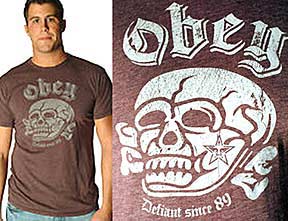 |
|
[The
skull and crossbones T-shirt marketed
by Fairey’s OBEY fashion line.]
|
|
|
In
2006 Fairey printed a near exact copy of an already
existing skull and crossbones artwork he found,
altering the original design only by adding the
words "OBEY: Defiant Since '89" along with a small
star bearing the face of Andre the Giant. The
image was reproduced as a T-shirt and added to
Fairey’s OBEY fashion line.
As
luck would have it, Wal-Mart plagiarized the master
plagiarist, copying and printing Fairey’s rip-off
and adding it to the superstore’s own fashion
line. A shopper at Wal-Mart recognized the skull
motif’s origin and angrily protested - as it was
an exact duplication of the infamous
logo belonging to the Gestapo, the Nazi "secret
state police" that served as personal bodyguards
to Adolf Hitler and administered the concentration
camps where the genocide of the Jewish people
was put into practice.
|
|
Unsurprisingly
Wal-Mart’s T-shirts
became a nationwide controversy, with legions
of infuriated citizens insisting the superstore
apologize and pull the offensive items from their
shelves - a demand that was ultimately met. Eventually
it came to light that Shepard Fairey was first
responsible for manufacturing and selling the
T-shirt, and when confronted
by the website, consumerist.com, Fairey offered
the following excuse: "When
I made that graphic I was referencing a biker
logo and it was only brought up to me later that
it was the SS skull." First,
Fairey openly admits to directly copying an image
created by someone else (he calls this "referencing"),
and then feigns innocence when faced with the
odious background of the original Nazi designers.
In the same set of remarks made to consumerist.com,
Fairey insists that he is "anti-fascist and pro-peace",
but what kind of anti-fascist does not recognize
the symbols used by the Nazi regime? Fairey’s
only defense here is full-blown ignorance - hardly
an attribute expected in artists supposedly dedicated
to social commentary.
|
|
|
|
[The
death’s head logo of the Nazi Gestapo.]
|
|
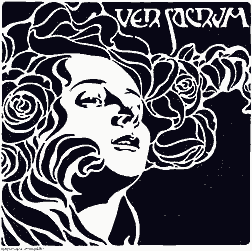 |
|
[Ver
Sacrum - Koloman Moser 1901. Front
cover illustration for the Vienna
Secession magazine, Ver Sacrum.]
|
|
|
Fairey
has incorporated Art Nouveau borders and graphic
flourishes in many of his posters, and there’s
no doubt in my mind that these elements were not
of his design. A conspicuous example of Fairey’s
plagiarism exists in his directly stealing the
work of Austrian artist Koloman
Moser (1868-1918), an important member of
the Vienna Secession movement - popularly known
as the Art Nouveau movement.
Moser
was not only a talented painter, he was also a
graphic artist who designed everything from architecture
and furniture to ceramics and jewelry. In 1901
Moser created the cover illustration shown at
left for the Vienna Secession movement’s journal,
Ver Sacrum (The Rite of Spring). The magazine
was published from 1898 to 1903, and during that
time it printed illustrations by most of the important
Secession artists.
|
|
Fairey
no doubt saw the cover art for Ver Sacrum
and created an exact tracing of it, a tracing
so precise that when the two versions are put
together and held up to the light - all lines
match perfectly. Fairey merely altered Moser’s
original work with some clumsy border enhancements,
a small portrait of Andre the Giant, and the words,
"OBEY Propaganda".
Nouveau
Black (shown at right), is Fairey's ripped-off
poster version of Moser’s art, a literal reproduction
of the original, with the border areas outside
of the original art embellished with lifeless
and crude lines drawn in by someone lacking in
draftsmanship. Needless to say, there was no credit
given to the original artist, Koloman Moser. An
exposé and further examination of this plagiarism
by Fairey can
be found here.
|
|
|
|
[Fairey's
ripped-off poster version of Moser’s art
.]
|
|
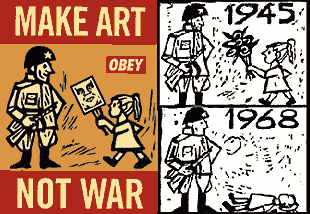 |
|
[
Left: Fairey’s plagiarized
poster. Right: Original street
poster from Czechoslovakia’s, Prague
Spring - Artist unknown 1968. The
poster depicts a Soviet Red Army soldier
in 1945 as a liberator, then as an
oppressor in 1968.]
|
|
|
When
the leader of the Communist Party of Czechoslovakia,
Alexander Dubcek, began to implement a series
of reforms in 1968, the Soviets feared a counterrevolution.
Moscow sent tanks and troops to crush the so-called
"Prague
Spring", but history means nothing to Shepard
Fairey, who can strip an image of historic meaning
faster than you can say "Czechoslovak Socialist
Republic".
During
the opening days of the Soviet occupation, Czech
patriots glued anti-invasion posters all over
the walls of Prague, the nation’s capital. One
daring but unidentified Czech artist created a
street poster that portrayed the Red Army as liberators
in 1945 - but oppressors in 1968. Fairey expropriated
that poster and republished it as his own, inserting
a portrait of Andre the Giant along with the words,
"Make Art, Not War".
|
|
It
goes without saying that Fairey has never mentioned
the Czech poster he plagiarized, and since posters
from the Prague Spring are virtually unknown outside
of the Czech Republic, he has so far gotten away
with calling this poster - like oh so many other
works of his - an original design. Recontextualizing
an image like the Prague Spring poster could afford
an artist opportunities to reveal forgotten recent
histories, linking them to current realities so
as to produce instructive political insights.
But all we get from Fairey is worn-out sloganeering
and self-promotion. One can only wish that Fairey
would take a cue from the clichéd catchphrase
on his poster and "Make Art" himself instead of
incessantly reframing and recycling the works
of others.
|
|
Shepard
Fairey ripped-off the historic artwork, One
Big Union, created by Ralph
"Bingo" Chaplin in 1917 for the Industrial
Workers of the World. Chaplin was a steadfast
American labor activist in the early 1900’s who
fought for unionism and worker’s rights at a time
when such activities could get you jailed or killed.
He
was a member of the IWW, an associate of famed
radical labor activists Mother Jones and "Big"
Bill Haywood, the author of the internationally
renowned worker’s anthem Solidarity Forever,
and an artist who supported himself by painting
portraits, working in commercial art studios,
and doing odd jobs for labor organizations.
|
|
|
|
[One
Big Union - Ralph "Bingo" Chaplin. 1917.
Artwork created for the Industrial Workers
of the World.]
|
|
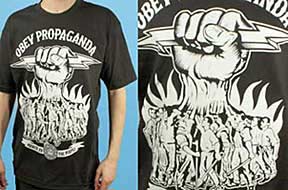 |
[
T-shirt created by Fairey for his
OBEY clothing line. Neither Chaplin
nor the IWW are given any credit by
Fairey. Click
here for a larger view of Chaplin’s
artwork.]
|
|
|
Some
of the period’s most memorable labor movement
graphics were created by Chaplin - including the
IWW’s infamous black cat icon, symbol of militant
direct action. To say that Chaplin’s contributions
to labor and American history is the stuff of
legend would be an understatement - but that didn’t
stop Fairey from stealing his art.
Fairey
made an exact copy of Chaplin’s One Big Union,
altering it only by putting a thunder bolt in
the clenched fist and adding the words, "OBEY
Propaganda". The stolen artwork was then printed
as a T-shirt and added to Fairey’s lucrative OBEY
fashion line. Of course, Fairey doesn’t bother
to credit Chaplin in any way, let alone draw attention
to Chaplin’s life and times.
|
|
Ruth-Marion
Baruch and her husband Pirkle Jones, became the
official photographers of the Black
Panther Party in early 1968. Baruch wanted
to do a photographic essay on the Panthers, and
when the director of San Francisco’s De Young
Museum told her his museum would show the works,
Baruch made contact with Kathleen Cleaver, the
party’s communications secretary and spokesperson.
The
photo essay project and museum exhibit was approved
by the Panther Party leadership, and the photographer’s
first assignment was to cover an Oakland demonstration
demanding the freedom of imprisoned Panther leader,
Huey P. Newton. One of the photos taken by Pirkle
Jones that day was of a young Panther listening
to speeches at the rally - that photographic image
was stolen by Fairey and made into the street
poster shown at right.
|
|
|
|
[
Left: Black Panther - Pirkle
Jones. Photograph. 1968. Portrait of an
anonymous Panther at a political rally in
Oakland, California. The Panther photos
of Ruth-Marion Baruch and Pirkle Jones are
internationally famous and have long been
available in book form. Right: Fairey’s
street poster, which neither credits Pirkle
Jones nor makes any mention of the Black
Panther Party.]
|
|
|
Shepard
Fairey’s ill-conceived poster ridiculously places
a badge of Andre the Giant on the Panther’s iconic
black beret, adding a single word along the bottom
of the design - "Obey". If the public at large
recognizes the image as that of a Black Panther
militant - and why would they - what, if any meaning,
could they possibly attach to such a visual? Pirkle
Jones gave us a compassionate image that served
the cause of African-American dignity and liberation,
while Fairey gave us a stolen and regurgitated
image stripped of all historical meaning and refashioned
to serve only one purpose - the advancement of
Fairey’s career.
|
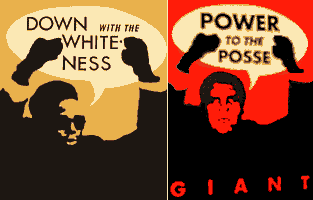 |
|
[
Left: Down with the Whiteness
- Rupert Garcia. Silkscreen print.
1969. In the permanent collection
of the Fine Arts Museum of San Francisco.
Right: Shepard Fairey’s rip-off
version of Garcia’s silkscreen. Fairey
published his plagiarized version
in his book, Supply and Demand.
No credit was given to Rupert Garcia.]
|
|
|
Rupert
Garcia is one of the founders of the late 1960’s
Chicano Arts Movement, and a personal hero of
mine. I first became aware of his works in 1975
when I saw his silkscreen posters published in
Towards Revolutionary Art (TRA), a radical
arts journal from the San Francisco Bay area of
California. Garcia
went on to develop a sophisticated graphic style
that combined social concern with magical realism,
producing large diptych and triptych paintings
and chalk pastel drawings. He’s currently represented
by the Rena
Bransten Gallery in San Francisco, and his
works are found in the collections of the Smithsonian
American Art Museum as well as the Fine
Arts Museums of San Francisco.
Of
the 82 prints by Garcia in the collection of the
Fine Arts Museums of San Francisco, it is his
silkscreen, Down With The Whiteness, that
concerns us here. Printed in 1969 as a solidarity
statement with the African-American Civil Rights
Movement, Garcia’s print echoed events then gripping
the US. Just a year prior, the Rev. Martin Luther
King Jr. had been assassinated in Memphis, Tenn.,
and riots swept the country from coast to coast.
Garcia captured the growing rage of African-Americans
with his silkscreen print.
|
|
Shepard
Fairey made a banal and imitative copy of Down
With The Whiteness as part of his ongoing
Andre the Giant poster series. But he never credited
or even mentioned Rupert Garcia. True to form,
Fairey removed all meaning and intent from Garcia’s
original by transforming the image into a portrait
of Andre the Giant. Adding the asinine slogan,
"Power to the Posse", Fairey completed the depoliticalization
of a classic poster by one of America’s great
political artists.
|
|
At
right is Liberate Puerto Rico Now!, a poster
created by an unknown artist from the Young
Lords Party in 1971. Shown at far right is
Fairey’s rip-off version, which does not credit
or mention the Young Lords Party. The original
Young Lords poster announced a 1971 conference
at Columbia University on the issue of Independence
for Puerto Rico. The event was co-organized by
the University’s Puerto Rican Student Union and
attended by some 1,000 students.
The
Young Lords were a political party founded in
the late 1960’s by Puerto Ricans living in Chicago
and New York. Modeled after the Black Panther
Party, the Young Lords preached independence and
self-determination for Puerto Rico, but also organized
to combat racism, poverty, police brutality, and
political oppression within Puerto Rican communities
in the United States. They defined themselves
as anti-imperialists who opposed the US war in
Vietnam.
|
|
|
|
[
Left: Liberate Puerto Rico Now!
- Young Lords Party. Silkscreen poster.
1971. Right: Fairey’s rip-off, "Wage
Peace: Obey", which neither credits
nor makes any mention of the Young Lords
Party.]
|
|
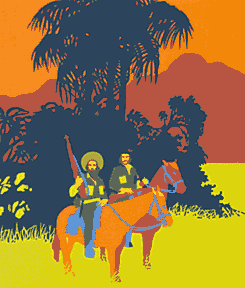 |
|
[
Untitled Silk-screen poster
- Rene Mederos, Cuba, 1972. This double
portrait by one of Cuba’s most famous
poster artists depicts the revolutionaries
Che Guevara and Camilo Cienfuegos.]
|
|
|
Lincoln
Cushing brought my attention to Shepard Fairey
having plagiarized a famous artwork by Cuban poster
maker Rene
Mederos, who was one of the finest Cuban poster
artists of the 1960s. The iconic works of Mederos
first came to the attention of Americans in the
early 1970s when Ramparts magazine published a
series of his posters dealing with the subject
of the Vietnam war.
The
stolen work in question, an untitled silk-screen
poster from 1972, portrayed the revolutionaries
Che Guevara and Camilo
Cienfuegos as guerilla fighters in the mountains
of Cuba. The Mederos poster had been reproduced,
with full permission from the Mederos estate,
in Cushing’s Revolución: Cuban Poster Art,
as well as David Kunzle’s book, Che Guevara:
Icon, Myth and Message.
Fairey
simply copied the Mederos poster in exacting detail,
had it printed as a T-shirt for his OBEY clothing
line, and sold it under the title of "Cuban Rider".
Rene Mederos was not credited or acknowledged
by Fairey in any way.
|
|
Spotting
Mederos’ stolen poster image on the bombingscience.com
website where Fairey’s clothing line is sold,
Cushing wrote the outlet the following e-mail:
"Please
be advised that the 'Cuban Rider' t-shirt you
have listed for sale is a direct copy of a poster
by Cuban artist Rene Mederos, and is an unauthorized
violation of his work. I work closely with the
Mederos estate and have represented them in several
arrangements for use of his work. Given that your
item is violating the intellectual property rights
of another artist, you can do one of two things
- either negotiate with Rene Mederos' estate for
a fair royalty (assuming that they will grant
it) or you can immediately stop production of
this item and remove advertising from the public.
Please let me know how you wish to proceed."
|
|
|
|
[
Screenshot taken from the "Bombing Science"
website 7/18/2007, where the Fairey rip-off
of Mederos’ poster was being sold as a T-shirt.
Fairey printed the graphic without permission
from the Mederos estate.]
|
|
|
Chris
Broders, Fairey’s partner in the OBEY clothing
brand, wrote Cushing back to acknowledge the copyright
violation, making the promise that the item would
be pulled from production and never sold again.
A current check of the Bombing Science website
shows that the illicit T-shirt has indeed been
pulled, and in mid-August, 2007, Cushing was contacted
by Fairey’s bookkeeper, who asked where a royalty
check for the Mederos estate should be sent. While
Fairey’s plagiarized version of the Mederos poster
was pulled from production, the details of this
controversy remained behind the scenes, until
now. Fairey never publicly acknowledged - let
alone apologized for - stealing the art of Rene
Mederos. If only that was the end of the story.
|
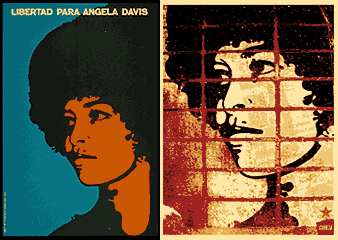 |
|
[
Left: Libertad para Angela
Davis (Freedom for Angela Davis)
- Félix Beltrán, Cuba, 1971. Original
silk-screen print created by Beltrán
in solidarity with Angela Davis when
she was a political prisoner in the
US. Right: Fairey’s plundered
version as a street poster, which
neither credits Beltrán nor identifies
Angela Davis.]
|
|
|
Not
content with stealing original artworks from Rene
Mederos, Fairey also filched art from another
celebrated Cuban poster maker, Félix Beltrán.
A well-known street poster by Fairey depicting
the celebrated 1960’s radical, Angela
Davis, is in fact a near-exact copy of a famous
silkscreen print by Beltrán.
Lincoln
Cushing identified Fairey’s poster as a copy of
Libertad para Angela Davis (Freedom for
Angela Davis), created by Beltrán in 1971. Fairey
gave no credit or recognition to the Cuban artist,
who is very much alive and residing in Mexico.
In addition, this particular theft of an existing
artwork of Angela Davis begs the question, does
Fairey mean to mock or praise leftist icons?
|
|
In
the 1960s psychedelic
poster artist Gary Grimshaw created eye-popping
concert posters for performances by the Doors,
Jimi Hendrix, The Who, Cream, and a multitude
of other bands. His posters helped set the standard
for the counter-culture poster art of the period.
In 1968 Grimshaw produced the image of a winged
white panther to serve as the emblem for the radical
White
Panther Party (WPP). Modeled after and inspired
by the Black Panther Party (BPP), the White Panthers
were a collective of hippie counterculture militants,
lead by poet John Sinclair and based in Detroit,
Michigan. They sought an emblem that would link
their efforts to those of the BPP, and Grimshaw’s
white panther logo was simply a variation of the
BPP logo - but both insignias were seen as political
organizing tools that were strictly not-for-profit
symbols.
The
BPP logo was itself an adaptation of the insignia
utilized by an early civil rights organization
in Alabama, the Lowndes County Freedom Organization.
Grimshaw’s winged white panther also came to be
used as the logo for the MC5, the rock band that
worked closely with the WPP to spread the idea
of youth rebellion. At the 1968 Democratic National
Convention in Chicago, the MC5 would give a legendary
performance in Lincoln Park before 5000 antiwar
protestors - just prior to Chicago riot police
attacking the crowd with tear gas, mace and nightsticks.
In 1969 John Sinclair was arrested, tried and
convicted for selling marijuana to an undercover
police agent, for which he received a ten year
prison sentence. An international movement for
Sinclair’s release was formed, and in December
1971, John Lennon, Yoko Ono, Stevie Wonder, Bob
Seger, Phil Ochs, and others performed on behalf
of the imprisoned White Panther Party leader at
a huge "John Sinclair Freedom Rally" concert in
Ann Arbor, Michigan. Again, Gary
Grimshaw designed the legendary poster for
that historic concert. Two days after the show,
the Michigan Supreme Court released Sinclair from
prison and later overturned his conviction.
|
|
Somewhere
along the line, Shepard Fairey discovered Grimshaw’s
winged panther artwork and without informing Grimshaw
or obtaining permission, copied the image in exact
detail for his OBEY clothing label. The plagiarized
image was printed as a series of T-shirts, jackets,
jeans and baseball caps utilizing the word "OBEY"
as part of the design.
On
Fairey’s
official website, he admits to stealing the
panther image. His misdeed was exposed only when
the wife and children of Michael Davis, bass player
for the MC5, purchased some of Fairey’s illicitly
produced attire from a clothing store. Mr. and
Ms. Davis immediately understood that Fairey had
stolen the image, so they tracked down Fairey
and asked for a meeting.
|
|
|
|
[
Left: MC5 at the Straight
- Gary Grimshaw 1969. Silkscreen concert
poster for an MC5 performance in San Francisco.
Right: Shepard Fairey’s ripped-off
version of Grimshaw’s panther as printed
by Fairey’s OBEY Clothing label.]
|
|
|
In
Shepard Fairey’s own words, here’s what happened
during those talks: "I met Michael Davis, bassist
of the MC5 when his wife Angela Davis (not related
to Black Panther Angela Davis, but an awesome
coincidence) basically busted me for using the
MC5 White Panther logo on an OBEY Clothing label.
It was the nicest bust ever because she said she
and Michael and their son were fans of Obey and
that we should do an official collaboration. I
wish all my busts ended up this well!"
First
off - Angela Davis was a member of the Communist
Party USA, not a member of the Black Panther
Party. Historical facts aside, Fairey’s words
about being "busted" for using the "MC5 White
Panther logo" is an admission of wrongdoing, and
when he states "it was the nicest bust ever" he
must surely be referring to examples like those
found in this article. Knowing that Gary Grimshaw
was the artist responsible for creating the White
Panther Party emblem, I looked him up on the internet,
apparently a feat much too bothersome and difficult
for Fairey or his assistants to have undertaken.
Grimshaw’s website reflects a decades long record
of creative output, and his late 60’s psychedelic
rock posters are well known examples of the genre.
After detailing Fairey’s plagiarism, I requested
Grimshaw’s comments on the matter. Here’s an except
of what he wrote back to me:
"The
panther image as created by Emory
Douglas (Black Panther Party Minister of Culture),
and as adapted by myself (White Panther Party
Minister of Art), exists in the public domain,
as it was intended. It is an icon that people
can identify with and organize around, and thus
must be free of copyright restrictions and onerous
ownership. That is the spirit in which the image
was created. The commercial exploitation of this
image is not strictly criminal because of its
public domain intent, but it reeks of the very
mean spirit that the image was meant to oppose.
I hope that Michael Davis who characterizes the
image as 'our [i.e. MC5] symbol', will recall
that shortly after the white panther with wings
first appeared in print on the poster I designed
for their appearance at the Straight Theatre in
San Francisco in 1969, the MC5 publicly disavowed
any affiliation with The White Panther Party;
at a time when the Party was struggling to free
its Chairman, John Sinclair, from the Michigan
State Penal System and keep three other Central
Committee Members under arrest warrant (including
myself) from a similar fate."
There’s
not much more that can be added to that unambiguous
and modest statement, though I will say this -
it’s obvious to me that Grimshaw’s winged white
panther is a unique creation to which Fairey can
lay no claim. Grimshaw has taken the moral highroad
by maintaining his artwork is in the public domain,
while insisting it be used only for political
and non-profit purposes. In exploiting the panther
logo for profit by printing it on boutique clothing,
Fairey has accelerated the dehistoricization and
commodification of American history, and in my
opinion, has forfeited his ability to speak as
a dissident.
|
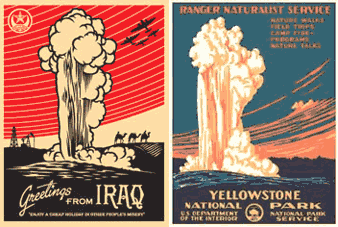 |
|
[
Left: Fairey's derivative poster,
Greetings from Iraq, printed
in 2005. Right: Ranger Naturalist
Service: Yellowstone National Park
- Artist unknown. Silkscreen. Circa
late 1930s. Created for the Works
Progress Administration (WPA) in order
to promote travel to America's national
parks. ]
|
|
|
President
Franklin Delano Roosevelt established the Works
Progress Administration (WPA) in 1935 as part
of his New Deal program. Millions of Americans
had lost their land, jobs or means of support
because of the Great Depression, and the WPA helped
put them back to work. The Federal Art Project
(FAP) of the WPA, administered all arts-related
endeavors from 1935-43, providing funding and
work for visual artists, writers, actors, and
musicians. FAP employed more than 5,000 artists
during its existence.
Mostly
remembered for the murals it subsidized across
the country, FAP was also responsible for generating
some 35,000
prints and posters; setting up divisions that
created prints in diverse styles using the techniques
of silkscreen, woodcut, linocut, and lithography.
FAP poster artists covered a multitude of topics
from health care and literacy, to labor and war
production, with a select
group of artists producing posters extolling
the beauty of, and encouraging visits to, America's
national parks. One such poster, Ranger Naturalist
Service: Yellowstone National Park, served
as source material for Shepard Fairey.
|
|
Fairey's
Greetings from Iraq is not a direct scan
or tracing of the FAP print, but it does indicate
an over reliance on borrowing the design work
of others. There was no political point or ironic
statement to be made by expropriating the FAP
print - it was simply the act of an artist too
lazy to come up with an original artwork. While
the geyser transformed into an explosion is the
focal point of Fairey's bland replication, every
other design element from the original work is
mirrored in Fairey's version; the sweep of the
sky, the horizon line, the rolling foreground,
even the placement of the text.
|
|
Can
Shepard Fairey honestly be described as an artist
who can critically assess the "unholy union of
government and big business," or offer comments
on the "underpinnings of the capitalist machine"?
Yet that is exactly how he is promoted in the
press release from the Merry
Karnowsky Gallery of Los Angeles, where his
solo exhibit Imperfect Union opens on December
1, 2007. Missing from that press release, and
all other promotional materials released by Fairey,
is any mention of his working hand in hand with
that "capitalist machine". In a Nov. 3, 2007,
interview with the Guardian, Fairey glibly stated,
"I’m not against capitalism. If I was, I wouldn’t
live in the US. If you get up everyday, work and
spend money, you’re participating. But that doesn’t
mean I don’t want to critique it." - or profit
handsomely from it for that matter.
PSFK,
the worldwide marketing agency that offers major
corporations services in "Advertising & Branding
Trends", held
a major conference in Los Angeles on Sept.
18, 2007. Entry to the symposium cost $300 per
ticket, and one of PSFK’s featured speakers was
Shepard Fairey, who shared the podium with Jean-Marie
Shields of Starbucks, Kenny Ochoa of Sony BMG,
and other luminaries from the corporate world.
One such figure was Conn Fishburn, a Yahoo executive
that presented a panel titled, "Our Role In Your
New World". Mr. Fishburn discussed "how the rise
of social networks gives agencies and their creative
teams a new and expanded role in shaping consumer
experience." PSFK’s press release described Fairey
as a "celebrated contemporary artist" who would
discuss "how he takes his art and applies it commercially."
Fairey gave his address before a well heeled audience
of corporate executives from Advanta - Nike, Inc.
- Saatchi & Saatchi LA - Visa USA - Warner Bros
Records - Young & Rubicam Brands, and a stunning
roster of other Fortune 500 companies. No doubt
the core of Shepard Fairey’s lecture focused on
the "unholy union of government and big business."
Some
supporters of Shepard Fairey like to toss around
a long misunderstand quote by Pablo Picasso, "Good
artists copy, great artists steal." Aside from
the ridiculous comparison of Fairey to Picasso,
there’s little doubt that Picasso was referring
to the "stealing" of aesthetic flourishes and
stylings practiced by master artists, and not
simply carting off their works and putting his
signature to them.
A
last ditch defense used by Fairey groupies is
to acknowledge that their champion does indeed
"borrow" the works of other artists both living
and deceased, but it is argued that the plundered
works are all in the "public domain", and therefore
the rights of artists have not been violated.
There are those who say that artists should have
the right to alter and otherwise modify already
existing works in order to produce new ones or
to make pertinent statements. Despite some reservations
I generally agree with that viewpoint - provided
that such a process is completely transparent.
However, I am outraged that anyone could make
a career out of the consistent, secretive and
wholesale copying of other people’s artworks.
Fairey has habitually used, without permission,
the works of other artists, both living and deceased.
To have created one or two works in such a manner
is perhaps forgivable, especially if there was
no money involved, but Fairey has developed a
profitable livelihood exclusively based on pilfering
the artworks of others.
The
expropriation and reuse of images in art has today
reached soaring heights, but that relentless mining
and distortion of history will turn out to be
detrimental for art, leaving it hollowed-out and
meaningless in the process. When I refer to "mining"
in this case I mean the hasty examination and
extraction of information from our collective
past as performed by individuals who do not fully
comprehend it. That is precisely what Fairey is
guilty of, utilizing historic images simply because
he "likes" them, and not because he has any grasp
of their significance as objects of art or history.
In 1916 Henry Ford, the famous American multimillionaire,
bigot, and founder of the Ford Motor Company,
uttered the infamous words, "History is Bunk."
That once outrageous statement has now become
part and parcel of postmodern art, as reflected
in Fairey’s own negligence regarding history.
If
carefully examined, the rebellious patina and
ersatz activism of Shepard Fairey’s art gives
way to reveal little in the way of political imagination.
Ultimately his work is the very embodiment of
"radical chic", bereft of historical memory and
offering only feeble gestures, babbling incoherencies,
and obscurantism as a challenge to the deplorable
state of the world. Such an artist cannot provide
us with a critical assessment of where we stand
today.
|
|
Critical
Voices
Plagiarize
\'pla-je-,riz also j - -\ vb -rized; -riz·ing
vt [plagiary] : to steal and pass off (the
ideas or words of another) as one's own
: use (a created production) without crediting
the source vi: to commit literary theft:
present as new and original an idea or product
derived from an existing source - pla·gia·riz·er
n (From Webster's New Collegiate Dictionary
9th ed, Springfield, Ma: Merriam 1981, p.
870).
|
|
|
A
smear campaign
against the author of this article is being
perpetrated by persons unknown. The attempt
at character assassination is being posted
on many blogs and websites that allow for
reader's comments. Referring to me, the
defamer writes, "The fact that he passed
out literature - including HIS OWN ART -
amongst those standing in line at Fairey's
show ought to tell you he's simply an opportunist."
Not only did I not attend the opening of
Fairey's Los Angeles exhibit at the Merry
Karnowsky Gallery, I've not been to the
gallery at any time during the show's run.
I've never attended any of Fairey's solo
exhibits. I have absolutely no knowledge
of, or connection to, any group or individual
who might have passed out the above article,
or my artworks, at Fairey's exhibit. If
anyone had proposed to me that such a course
of action be taken, I would have adamantly
forbidden the use of the article, and my
artworks, to be used in that manner.
|
|
|
Josh
MacPhee,
a co-researcher for the above article, offers
further comments on image appropriation
on the JustSeeds
web log. Quoting MacPhee: "One
important thing to acknowledge is that Fairey
is not just appropriating, but also copyrighting
images that exist in our common history.
Posters and graphics made in the heat of
political struggles are often made by anonymous
individuals or groups that want to keep
the images in the public domain for use
in further struggle. It is unfortunate that
Fairey is attempting to personally capitalize
on the generosity of others and privatize
and enclose the visual commons (as seen
by the prominent copyright symbols on his
website and products)."
|
|
|
If
the Copy Is an Artwork, Then What's the
Original? -
That's the title of a New York Times article
apropos to the "appropriation art" of Fairey.
The NYT piece focuses on postmodernist photographer
Richard Prince, who has made a career from
photographing photos taken by other photographers.
Prince has copied several photos made by
photographer Jim Krantz - without permission
or attribution. Commenting on his works
being appropriated, Krantz said: "My whole
issue with this, truly, is attribution and
recognition. It's an unusual thing to see
an artist who doesn't create his own work,
and I don't understand the frenzy around
it. If I italicized 'Moby-Dick,' then would
it be my book? I don't know. But I don't
think so."
|
|
|
Lincoln
Cushing, a co-researcher of this article,
wants the debate on expropriated images
to remain constructive, so he wrote a guide
titled "Best
practices for using the graphic artwork
of others". One of the points
in his guide for poster makers reads in
part: "Give specific credit on the final
piece. This is important for all items,
including ones that have drifted into that
giant grab-bag we call the 'public domain.'
Don't contribute to our own historical amnesia
and cultural imperialism. Say something
about where it's from. This can be as simple
as a credit line at the bottom in small
type."
|
|
|
Mat
Gleason is an art critic, writer, and publisher
of the Coagula
Art Journal of Los Angeles, California.
In a video interview that appeared in the
Ovation Network documentary, Art or Not,
Gleason compared Fairey's art to advertisments
for Coca-Cola, saying; "They're both on
the street, they're both promoting a brand,
and at the end of the day, it's a very empty
experience." Gleason went on to say that,
"I think that the art experience is to raise
someone's consciousness, and at the end
of the day the Shepard Fairey experience
is to promote the brand of Shepard Fairey
as a corporate entity, so I don't consider
it art. He is about the furthest thing from
art there is." View
Art or Not.
|
|
|
|